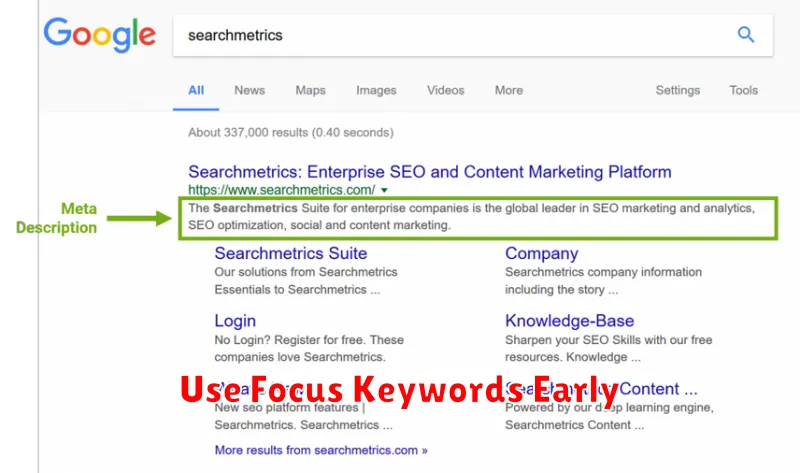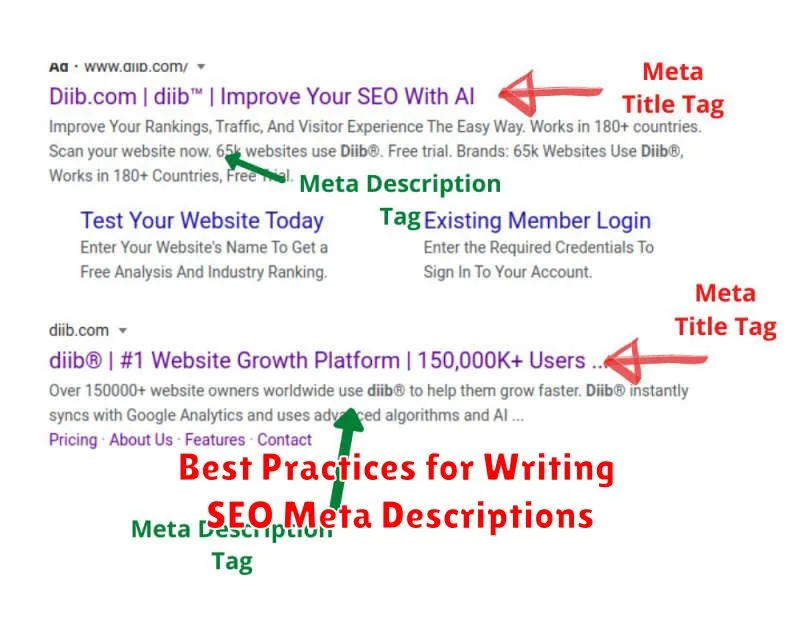Crafting compelling and effective meta descriptions is a crucial aspect of search engine optimization (SEO). A well-written meta description serves as a concise summary of your webpage’s content, enticing users to click through from search engine results pages (SERPs). By implementing best practices, you can significantly improve your click-through rate (CTR) and drive more organic traffic to your website. This article will delve into the best practices for writing SEO meta descriptions that not only attract users but also align with search engine algorithms.
Optimizing your meta descriptions requires a strategic approach, considering both the user experience and SEO best practices. From understanding character limits to incorporating relevant keywords and crafting compelling calls to action, mastering the art of the meta description can significantly impact your website’s visibility and success in search rankings. This guide will provide actionable insights into how to write effective meta descriptions that improve your SEO performance and attract your target audience. Learn how to create meta descriptions that accurately reflect your content and encourage clicks, ultimately boosting your website’s organic traffic.
Why Meta Descriptions Matter
Meta descriptions play a crucial role in search engine optimization (SEO). While they don’t directly impact rankings, they significantly influence click-through rates (CTRs) from search engine results pages (SERPs). A well-crafted meta description can entice users to click on your link instead of a competitor’s, driving organic traffic to your website.
Think of your meta description as an advertisement for your webpage. It’s a concise summary that tells users what to expect when they click. A compelling and informative meta description can improve your website’s visibility and attract the right audience. Conversely, a poorly written or missing meta description can lead to lower CTRs, even if your page ranks high in search results.
Key benefits of effective meta descriptions include:
- Increased CTRs
- Improved visibility in search results
- Better user engagement
- Attracting qualified leads
Use Focus Keywords Early

Search engines place more emphasis on keywords appearing earlier in the meta description. Front-loading your focus keyword helps search engines quickly understand the page’s topic and relevance to a user’s search query. This practice can improve your click-through rate as users are more likely to click on results where their search terms are prominently displayed.
While using your keyword early is beneficial, avoid keyword stuffing. Unnaturally repeating the keyword multiple times in the meta description appears spammy and can negatively impact your ranking. Focus on writing a concise and compelling description that naturally incorporates your target keyword near the beginning.
Limit to 155 Characters
One of the most critical aspects of crafting effective meta descriptions is adhering to the character limit. Search engines typically truncate descriptions beyond a certain length, usually around 155-160 characters. This truncation can leave users with an incomplete or misleading impression of your page’s content.
By keeping your meta descriptions concise and within the recommended 155-character limit, you ensure that the entire message is displayed in search results. This provides users with a clear and comprehensive understanding of what your page offers, increasing the likelihood of clicks and improving your click-through rate (CTR).
While exceeding the limit isn’t a direct ranking factor, a truncated description can negatively impact user experience, leading to lower CTRs and potentially affecting your search performance indirectly. Conciseness is key; focus on delivering value and enticing users within the prescribed character count.
Make It Action-Oriented
A compelling meta description encourages users to click through to your website. One effective method is to make it action-oriented. Think of it as a mini call-to-action, prompting users to take the next step.
Instead of simply describing the page content, use action verbs and phrases that inspire interaction. For example, instead of “Information about blue widgets,” try “Learn everything you need to know about blue widgets” or “Shop our selection of blue widgets today.” These active phrases create a sense of urgency and encourage users to click.
Use words like “discover”, “explore”, “learn”, “shop”, or “get” to entice users. By framing your meta description with an action-oriented approach, you can significantly increase your click-through rate and drive more traffic to your website.
Avoid Duplication Across Pages
Duplicate meta descriptions, like duplicate title tags, can be problematic for search engines. When multiple pages have the same description, it becomes difficult for search engines to understand the unique value proposition of each page. This can negatively impact your click-through rates and overall search performance.
Each page should have a unique and compelling meta description that accurately reflects its content. This helps search engines understand the specific topic and keywords associated with each page, allowing them to rank your content more effectively for relevant searches.
While it might be tempting to reuse descriptions, especially on large websites, investing the time to craft unique descriptions is crucial for long-term SEO success. Consider using a spreadsheet or content management system (CMS) to track your meta descriptions and ensure there are no duplicates.
Use Unique Descriptions per Page
Duplicate meta descriptions are a common SEO mistake. Search engines may view duplicate descriptions as a sign of low-quality content, potentially impacting your search rankings. Each page on your website serves a unique purpose and targets specific keywords. Therefore, each page deserves a unique and compelling meta description that accurately reflects its content.
Crafting unique descriptions for each page allows you to optimize for specific keywords relevant to that particular page’s content. This targeted approach helps search engines understand the context of each page, improving its visibility for relevant search queries.
Furthermore, distinct meta descriptions provide users with a clear and concise preview of what to expect on each page. This helps improve click-through rates from search engine results pages (SERPs), as users are more likely to click on a result that clearly addresses their search intent.
Test CTR Using Search Console
Google Search Console provides invaluable data for analyzing the click-through rate (CTR) of your meta descriptions. This data allows you to measure the effectiveness of your descriptions in attracting clicks from search engine results pages (SERPs).
Access the Performance Report within Search Console. This report displays queries that led users to your site, along with the corresponding pages. Crucially, it shows impressions, clicks, and the calculated CTR for each.
Analyze the data by sorting by impressions. Identify pages with a high number of impressions but a low CTR. These pages represent opportunities for improvement. Experiment with rewriting meta descriptions for these pages, incorporating relevant keywords and compelling calls to action.
After implementing changes, continue to monitor the Performance Report. Track changes in CTR to see if your revisions have a positive impact. This iterative process of testing and refining will help you optimize your meta descriptions for maximum CTR.

